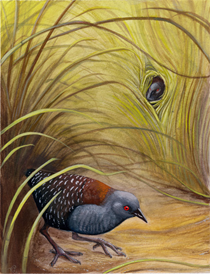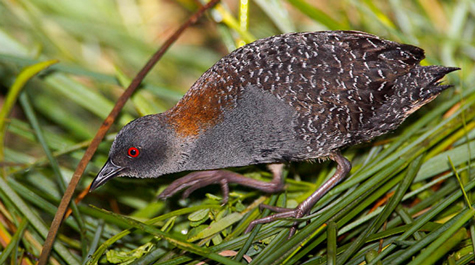The black rail: A bird that’s been flying under the radar since Audubon’s day
The eastern black rail is small, secretive, mysterious and in trouble.
It’s a sparrow-sized marsh bird. It hardly ever flies, and gets around by creeping through dense wetland vegetation. The black rail is a blank spot on many a life list and even most of the sightings are really “hearings,” the birder identifying the species by its call — which often comes from a dark swamp in the dead of night.
“Most people haven’t seen one. Most birders haven’t seen one,” Bryan Watts said. “It’s one of those species that beats birders.”
Watts, the director of the Center for Conservation Biology, has assembled a report called “Status and distribution of the eastern black rail along the Atlantic and Gulf Coasts of North America.” The report to the U.S. Fish and Wildlife Service is part of a 15-year effort spearheaded by the CCB to get the black rail on the federal register of endangered and threatened species.
It’s the definitive document on the state of this endangered bird in the eastern U.S., but even this definitive document contains a large amount of uncertainty, largely because the black rail has been flying below the radar of professional ornithologists and birders alike since Audubon’s day.
Estimated population varies widely
The study area covers the Atlantic and Gulf Coastal states from Maine to Texas, plus Vermont, West Virginia and Tennessee. The report gives a wide range in estimated black rail population in the area — 455 to 1,315 breeding pairs. Just three states, South Carolina, Florida and Texas, account for three quarters of the overall total. Watts said that Florida and Texas population estimates carry a high uncertainty rating, because of the large expanses of likely, but unsurveyed, black rail habitat in those two states.
“There has been all this mystery around black rails because birders just can’t get onto them,” Watts said. “They occur in all these places that are away from where birders have access to.”
Black rails were discovered breeding in Philadelphia more than 150 years ago, but today there are huge blank spots in even the most basic knowledge about the birds. Watts says that all of the information on the population existed in bits and pieces scattered throughout more than 100 years of journals, museum specimens and unpublished observations.
“People ask, ‘What’s in the literature?’ Well, what’s in the literature is little, tiny bits and pieces,” he said. “The literature goes back to the beginning, which was 1836 in North America.”
Spoiler: We don’t know much about this bird
 Watts began by compiling a bibliography of black rail observations, wading through more than 6,000 journal issues, checking out museum collections and downloading black rail records from e-bird, the online birding checklist run by the Cornell Laboratory of Ornithology.
Watts began by compiling a bibliography of black rail observations, wading through more than 6,000 journal issues, checking out museum collections and downloading black rail records from e-bird, the online birding checklist run by the Cornell Laboratory of Ornithology.
Watts summed up his findings of looking through decades of ornithological research: Naturalists have never had a good handle on the black rail. There’s never been a status assessment on the species, he said, because there isn’t much survey data.
“You go back to the very beginning; they didn’t know anything about this bird,” he said. “You come up to the present; we still don’t know anything about this bird. It’s because of how secretive it is.”
The birds spend their lives deep in tussocky marshes, making them an extremely challenging species to study. Very few black rails have been banded and their breeding habits are imperfectly understood. Black rails are not even particularly birdlike: Watt’s report contains a quote that describes them as “a feathered mouse.”
“And that’s the way they behave, too,” he said. “They rarely take flight. They just scurry around. People get little, tiny glimpses of them scurrying between the vegetation. Rails are that way in general, but black rails are off the charts when it comes to how secretive they are.”
A perfect drought of information
The black rail situation illustrates the degree to which the Center for Conservation Biology and other professional ornithologists rely on the reports of amateur birders. Their secretive habits, preference for out-of-the-way habitat and comparative rarity make the black rail a challenge for recreational birders.
Very serious birders will go out of their way to list a black rail, but the black rail is not the least bit charismatic and not particularly attractive. So once a birder checks Laterallus jamaicensis off a life list, he or she is unlikely to go out of the way to look for more black rails. The habits of the birds, combined with the habits of birders, create a perfect drought of information.
“We know the distribution of a lot of bird species because birders are good at documenting their location,” Watts explained. “There are some exceptions to that, and the black rail is one, because they are so challenging and many birders aren’t up to that.”
Watts said the CCB began its campaign to bring the black rail out of ornithological obscurity about 15 years ago. “We started the Eastern Working Group — I think it was in 2009 — meeting with biologists throughout the range, trying to get momentum going,” he said. “This particular effort was to compress 150 years of literature and bring us up to the present, so we can stop looking back and hopefully look forward.”
Despite the challenges posed by gathering patchy evidence on a secretive avian subject, Watts’ report arrives at some pretty solid conclusions. Most importantly, he says, the black rail is in trouble as a species.
“It looks like they’re falling off a cliff,” he said, adding that northern populations have experienced a particular crash in numbers. Overall, Watts said, the outlook isn’t good for black rails anywhere in their range: The last record of a black rail observation in Virginia dates to 2014.
Getting flooded out by sea level rise
Secondly, the report notes that much of the bird’s preferred habitat — or what’s left of it — is doomed, mostly by sea-level rise. Watts said that black rails are known to use a variety of marshy areas, including inland wetlands, ponds, grassy fields and coastal prairies. But 60 percent of the documented sites in the study were classified as tidal salt marsh. To be precise, Watts said, black rails prefer high tidal marsh areas.
“They don’t like standing water,” Watts said. “Now, a Virginia rail will build its nest right above standing water. Black rails won’t do that. They want to have moist soil, but not be in the water. They occupy such a narrow hydrologic band of habitat.”
Watts said that rising sea levels will inundate the black rails’ narrow hydrologic band, the area that’s normally dampened by only the highest lunar tides. As the narrow band narrows further, the birds are forced out.
In fact, Watts notes that much of the black rail’s habitat has been long gone. Black rails were first discovered in 1836 by Thomas Rowan on a farm near Philadelphia. Rowan sent his specimens to one Titian Peale, who passed them along to John James Audubon himself. Those first-discovered birds were the basis of the black rail plate in Audubon’s Birds of America.
“That farm, where Rowan first discovered the species? It’s now the Philadelphia airport,” Watts said. It’s just one example of the extensive loss of wetlands done in post-Civil War period in the name of reclamation, mostly for agricultural use.
A crashing population and disappearing habitat make the black rail’s prospects rather dim, and Watts acknowledges that the ornithological community and regulators are late in getting the bird’s plight under serious consideration.
Watts said that the CCB’s report will give Fish & Wildlife the information they need to move forward with a designation as per the federal Endangered Species Act. He said he believes the black rail merits a “threatened” designation, denoting a species that is not at the brink of extinction, but is likely to be at the brink in the near future.
After the black rail goes on the protected list, Watts said the next step would be to prepare a management plan to maintain the population. In the meantime, the black rails that remain in the east will have to rely on their old defense of extreme secrecy.
The Center for Conservation Biology is a joint program of William and Mary and Virginia Commonwealth University.
 Skip to main content
Skip to main content

